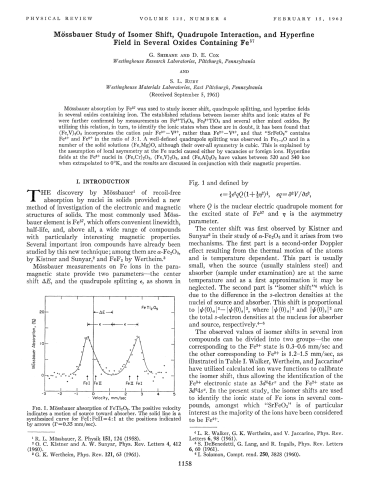Mössbauer Study of Isomer Shift, Quadrupole Interaction, and Hyperfine Field in Several Oxides Containing Fe57

Mossbauer absorption by Fe57 was used to study isomer shift, quadrupole splitting, and hyperfine fields in several oxides containing iron. The established relations between isomer shifts and ionic states of Fe were further confirmed by measurements on Fe'+Ti205, Fe2'+Ti05 and several other mixed oxides. By utilizing this relation, in turn, to identify the ionic states when these are in doubt, it has been found that V'+, (Fe, V)203 incorporates the cation pair Fe'+ — rather than Fe'+ — V4+, and that "SrFe03" contains Fe4+ and Fe'+ in the ratio of 3:1. A well-de6ned quadrupole splitting was observed in Fe&, O and in a number oi the solid solutions (Fe, Mg)O, although their over-all symmetry is cubic. This is explained by the assumption of local asymmetry at the Fe nuclei caused either by vacancies or foreign ions. Hyperfine fields at the Fe'+ nuclei in (Fe, Cr)&Oq, (Fe, v)203, and (Fe, A1)s03 have values between 520 and 540 koe when extrapolated to O'K, and the results are discussed in conjunction with their magnetic properties.
This result is in accordance with the model that the hyperfine field observed by the Mossbauer measurements is proportional to the moment at a given temperature, and not to the component of the moment along the magnetic axis. The latter may be affected by local fluctuations caused by the number of Fe neighbors but the moment itself retains the proper value for Fe'+. In the metallic Fe — Al system, on the other hand, the moment is dependent upon the distribution amongst the nearest metal neighbors.